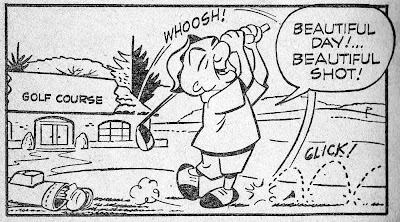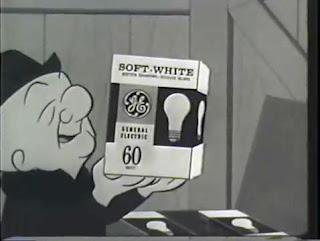Despite the overwhelming positive response to Mr. Magoo’s Christmas Carol, the studio largely lay fallow through 1963. Once again, as was (and still is) common for animation studios, most of the staff had been let go at the end of production and only a few key artists stayed on, in this case, to handle the demands of the General Electric TV commercials featuring Magoo. Mr. Magoo was considered an “in” property at the time and continued to generate income through licensing and merchandising even if he wasn’t actively utilized in production. Saperstein expanded his Magoo empire by developing and selling a Mr. Magoo comic strip to the Los Angeles Times Syndicate around this time. (Above, a panel from the strip, drawn by the versatile Pete Alvarado.)
But considering the success of the special, it's a bit puzzling that, aside from the TV commercials, Magoo made no new broadcast or film appearances during 1963. Without having access to the UPA production records, it's difficult to know exactly what happened during this "lost" year. What seems likely, though, is that UPA had been caught flat footed with the unexpected success of the special. In Hollywood, success demands more of the same so it's not unreasonable to assume that NBC immediately requested a follow up and UPA would have had to scramble to come up with something.
Some of the answer to what happened in 1963 might be in a letter recently discovered in Abe Levitow's files. Although it seems like a natural progression to take the central conceit of Mr. Magoo's Christmas Carol, Magoo as an actor in literary classics, and expand it into a series, this letter indicates that the path was anything but a straight line. The letter, dated June 6, 1963, addressed to Abe Levitow, is from Chris Hayward, one of the staff writers at Jay Ward (Hayward is credited as the creator of Dudley Do-Right and future co-developer of The Munsters). It's unusual for competing animation studios to collaborate, but in my book I note the frequent interchange of personnel between UPA and Jay Ward throughout the 1960s. Now, it appears that the relationship between the two studios might have been even closer than first realized.
Hayward begins:
I think we can now generally agree that depositing Magoo in a proper and saleable vehicle provides with us what we can label one hell of an enigma.
When the character first erupted on the screens, he was dug by kids but I think mostly by adults, appealing to that select group of connoisseurs who now rapture joyously over the Hubley and Pintoff offerings.
In his next paragraph, he nails the central problem with the then current incarnation of Magoo:
The five minute cartoon TV series wiped out the avant garde fans, capitalizing instead on the tousled haired set from five to fifteen.
He continues to analyze the situation and then begins his proposal:
Currently in vogue is the dashing James Bond character, hero in sundry novels and recently in motion pictures. Bond is the epitome of the secret secret service agent, thriving on deadly action, good booze, and an unending stream of delectable broads.
...Anyway, it might be fun making Magoo into a blase, man-of-the-world crime-solver, maintaining a lush penthouse suite in Manhattan, dining in elegant bistros educating an already glutted epicurean palate, pursued by a coterie of lovely vixens smitten by his ruddy maturity, and dedicating the twilight years of his life bringing scoundrels to justice.
At no point was Hayward suggesting that UPA continue to capitalize on Magoo's nearsightedness. Instead, he saw Magoo as an adult level character again, although he may have been overreaching by pitching Magoo's involvement with the three Bs, booze, broads and bad guys. It was an intriguing notion but once a character has crossed into the juvenile market, it's virtually impossible to bring them back. Most likely UPA realized that as well, as the matter appears to have been dropped. Hanna Barbera later capitalized on the Bond craze, albeit with less panache than Chris Hayward was suggesting, with their feature length film, The Man Called Flintstone. And Hayward did get to explore his takeoff on the James Bond films when he wrote for the spy spoof TV series, Get Smart.
Eventually, the studio did adopt the idea of Magoo starring in literary classics, which became The Famous Adventures of Mr. Magoo. This correspondence makes one wonder, though, what other proposals were explored during that year to capitalize on the success of Mr. Magoo's Christmas Carol?




6 comments:
Perhaps if the five minute cartoon series had been better written, it might have still appealed to adults. I remember liking it, but asking Mom why 'Cholly' talked so funny.
THE FLINTSTONES was a cartoon that appealed to both adults and kids. It was well written and ran in primetime. I don't think that turning Magoo into Bond would have helped him.
Hi. I saw you on History Channel's The Real Story of Christmas. I have never seen Magoo's Christmas Carol, but after reading through your website (and the wikipedia listing for the film) I just ordered your book. Does the film air on tv anymore? Thanks!
Thanks for ordering the book, especially since you've never seen the special! The film has been off TV for a number of years but I've heard rumors that it might be on again starting next year.
Hi. Thanks for the reply. I was a fan of the 60s Magoo tv series, but, as mentioned, have never seen Magoo's Christmas Carol. I ordered the movie on amazon video on demand (along with your book). I'm a huge fan of all the classic Christmas tv specials (Rudolph, Grinch, Santa Claus is Comin' to Town, Frosty, etc.), but for whatever reason Magoo Christmas Carol escaped me over the decades.
I recall seeing many of the five minute Magoos in 35mm at our local movie theater during the summer of 1963 in a weekly 'cartoon carnival' program, mixed with some of the superior UPA theatrical Magoos. The cheaply made TV cartoons were never intended to be projected so large and such a presentation over time did much to bury UPA's earlier rep as a provider of exquisite modern graphics.
Post a Comment